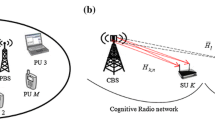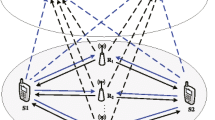Abstract
In this paper, we study the resource allocation problem in multiuser Orthogonal Frequency Division Multiplexing (OFDM)-based cognitive radio networks. The interference introduced to Primary Users (PUs) is fully considered, as well as a set of proportional rate constraints to ensure fairness among Secondary Users (SUs). Since it is extremely computationally complex to obtain the optimal solution because of integer constraints, we adopt a two-step method to address the formulated problem. Firstly, a heuristic subchannel assignment is developed based on the normalized capacity of each OFDM subchannel by jointly considering channel gain and the interference to PUs, which approaches a rough proportional fairness and removes the intractable integer constraints. Secondly, for a given subchannel assignment, we derive a fast optimal power distribution algorithm that has a complexity of O(L 2 N) by exploiting the problem’s structure, which is much lower than standard convex optimization techniques that generally have a complexity of O((N + K)3), where N, L and K are the number of subchannels, PUs and SUs, respectively. We also develop a simple power distribution algorithm with complexity of only O(L + N), while achieving above 90 % sum capacity of the upper bound. Experiments show that our proposed algorithms work quite well in practical wireless scenarios. A significant capacity gain is obtained and the proportional fairness is satisfied perfectly.







Similar content being viewed by others
Notes
It consumes too much time to work out the solutions for the commercial software to get the upper bound, so we only consider a small scale of users.
References
Federal Communications Commission. (2003). Facilitating opportunities for flexible, efficient, and reliable spectrum use employing cognitive radio technologies. FCC Report, ET Docket 03-322.
Mitola, J., & Maguire, G. (1999). Cognitive radio: Making software radios more personal. IEEE Personal Communications, 6(4), 13–18.
Marinho, J., & Monteiro, E. (2012). Cognitive radio: Survey on communication protocols, spectrum decision issues, and future research directions. Wireless Networks, 18(2), 147–164.
Federal Communications Commission. (2003). Spectrum policy task force report. FCC Report, ET Docket 02-135.
Weiss , T., & Jondral, F. (2004). Spectrum pooling: An innovative strategy for the enhancement of spectrum efficiency. IEEE Communications Magazine, 42(3), 8–14.
Wong, C., Cheng, R., Lataief, K., & Murch, R. (1999) Multiuser OFDM with adaptive subcarrier, bit, and power allocation. IEEE Journal on Selected Areas in Communications, 17(10), 1747–1758.
Suh, C., & Mo, J. (2008). Resource allocation for multicast services in multi-carrier wireless communications. IEEE Transactions on Wireless Communications, 7(1), 27–31.
Tao, M., Liang, Y.-C., & Zhang, F. (2008). Resource allocation for delay differentiated traffic in multiuser OFDM systems. IEEE Transactions on Wireless Communications, 7(6), 2190–2201.
Ho, W. L., & Liang, Y.-C. (2009). Optimal resource allocation for multiuser MIMO-OFDM systems with user rate constraints. IEEE Transactions on Vehicular Technology, 58(3), 1190–1203.
Shen, Z., Andrews, J., & Evans, B. (2005). Adaptive resource allocation in multiuser OFDM systems with proportional rate constraints. IEEE Transactions on Wireless Communications, 4(6), 2726–2737.
Sadr, S., Anpalagan, A., & Raahemifar, K. (2009). Radio resource allocation algorithms for the downlink of multiuser OFDM communication systems. IEEE Communications Surveys & Tutorials, 11(3), 92–106.
Bansal, G., Hossain, M., & Bhargava, V. (2008). Optimal and suboptimal power allocation schemes for OFDM-based cognitive radio systems. IEEE Transactions on Wireless Communications, 7(11), 4710–4718.
Zhang, Y., & Leung, C. (2009). Resource allocation in an OFDM-based cognitive radio system. IEEE Transactions on Communications, 57(7), 1928–1931.
Wang, S. (2010). Efficient resource allocation algorithm for cognitive OFDM systems. IEEE Communications Letters, 14(8), 725–727.
Wang, S., Huang, F., & Zhou, Z.-H. (2011). Fast power allocation algorithm for cognitive radio networks. IEEE Communications Letters, 15(8), 845–847.
Gu, H., Wang, S., & Li, B. (2011) Maximize sum capacity of multiuser cognitive OFDM systems. In Proceedings of the 20th annual wireless and optical communications conference, pp. 1–5.
Zhang, Y., & Leung, C. (2009). Resource allocation for non-real-time services in OFDM-based cognitive radio systems. IEEE Communications Letters, 13(1), 16–18.
Attar, A., Nakhai, M., & Aghvami, A. (2009). Cognitive radio game for secondary spectrum access problem. IEEE Transactions on Wireless Communications, 8(4), 2121–2131.
Almalfouh, S. M., & Stuber, G. L. (2011) Interference-aware radio resource allocation in OFDMA-based cognitive radio networks. IEEE Transactions on Vehicular Technology, 60(4), 1699–1713.
Mitran, P., Le, L., & Rosenberg, C. (2010). Queue-aware resource allocation for downlink OFDMA cognitive radio networks. IEEE Transactions on Wireless Communications, 9(10), 3100–3111.
Ge, M., & Wang, S. (2012). Fast optimal resource allocation is possible for multiuser OFDM-based cognitive radio networks with heterogeneous services. IEEE Transaction on Wireless Communication, 11(4), 1500–1509.
Wang, S., Huang, F., Yuan, M., & Du, S. (2012). Resource allocation for multiuser cognitive OFDM networks with proportional rate constraints. International Journal of Communication Systems, 25(2), 254–269.
Attar, A., Holland, O., Nakhai, M., & Aghvami, A. (2008). Interference-limited resource allocation for cognitive radio in orthogonal frequency-division multiplexing networks. IET Communications, 2(6), 806–814.
Boyd, S., & Vandenberghe, L. (2004). Convex optimization. Cambridge University Press, New York.
Nocedal, J., & Wright, S. (2006). Numerical optimization (2nd edn.). Berlin: Springer.
Bertsekas D. (2006) Convex analysis and optimization. Athena: Athena Scientific Press.
Daniels, R. (1974). Approximation methods for electronic filter design New York: McGraw-Hill.
Goldsmith, A., & Chua, S. (1997). Variable-rate variable-power MQAM for fading channels. IEEE Transactions on Communications, 45(10), 1218–1230.
Acknowledgments
This work was partially supported by the Jiangsu Science Foundation (BK2011051), the Fundamental Research Funds for the Central Universities (1095021029, 1118021011), and the NSFC.
Author information
Authors and Affiliations
Corresponding author
Appendix: Proof of Theorem 1
Appendix: Proof of Theorem 1
We propose an L + 1 iterations procedure to solve (16). Define s + 1 intermediate variables, \(u_1^s,u_2^s,\ldots,u_{s+1}^s \in {\mathbf R}^{N+K-1}\) at step \(s, s=1,2,\ldots,L+1\), the procedure is illustrated as follows. Step 1: since H 1 = H 2 + G 1 G T1 , we have
and u 11 , u 12 can be calculated as
Step \(s:\, s=2,\ldots,L\). As H s = H s+1 + G s G T s , we have
and we need to solve the following s + 1 equations
Step L + 1: we need to solve the following L + 2 equations at this step
Without loss of generality, each equation in (34) can be written as
where \(x, G \in {\bf R}^{N\times1}\) and \(\nu \in {\bf R}^{(K-1)\times 1}\). Recall that D is a diagonal matrix, denote \(\theta_k = N - \sum_{i=k}^{N}N_i\), we have
\(i=1,2,\ldots,N_k\) for \(k=1,2,\ldots,K\). And from (36), we have
where \(X_k = \sum\limits_{i=1}^{N_k} u_{\theta_{k}+i},\,a_k = \sum\limits_{i=1}^{N_k} \frac{h_{\theta_{k}+i}}{\lambda_{\theta_{k}+i}},\,b_k = \sum\limits_{i=1}^{N_k}\frac{1}{\lambda_{\theta_{k}+i}}\). Using the set of equations in (37), we can obtain
As ν k is worked out by (38), we can insert it to (36) to obtain u. The computation cost is O (K + N). Since K≪ N in practice, the complexity can be denoted as O (N).
Note that there are L + 2 equations in (34), each equation can be solved with complexity O (N). We carry out an inverse process by using the intermediate variables until Newton step x is worked out. In total, we should calculate L 2 + 3L + 3 variables and the complexity of computing each variable is O (N). So the complexity of our proposed power allocation algorithm is O (L 2 N).
Rights and permissions
About this article
Cite this article
Wang, S., Huang, F. & Wang, C. Adaptive proportional fairness resource allocation for OFDM-based cognitive radio networks. Wireless Netw 19, 273–284 (2013). https://doi.org/10.1007/s11276-012-0465-9
Published:
Issue Date:
DOI: https://doi.org/10.1007/s11276-012-0465-9




